Prevent winter desiccation on creeping bentgrass
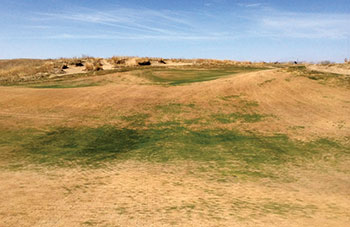
Figure 1 Typical symptoms of winter desiccation injury on a creeping bentgrass fairway at the Awarii Dunes GC site. Low areas had minimal damage, while exposed slopes had widespread winterkill. (Photo: Bill Kreuser)
Winter injury from desiccation is a leading cause of turf loss across the northern and central Great Plains. Desiccation occurs whenever turfgrass water loss exceeds its ability to acquire water from the soil.
Desiccation can happen at any time of the year, although most superintendents likely associate desiccation with hot and dry summer conditions. During open winters, the combination of wind, fluctuating air temperature and frozen soil leads to significant turf desiccation. Exposed and elevated sites or locations with sandy soils are most prone to desiccation. All of these conditions are present throughout much of the Great Plains. In severe cases, they can cause the turf crown to dehydrate and die.
The winter of 2013-14 was challenging for many golf course superintendents across North America. Superintendents in southeastern North America had widespread winterkill on bermudagrass (Cynodon spp.) following extremely cold winter conditions, and many annual bluegrass (Poa annua L.) managers around the Great Lakes had to deal with months of ice encasement.

Table 1 Treatment list of the winter desiccation prevention treatments evaluated at the five research sites during the winters of 2014-15 and 2015-16. (Chart: Bill Kreuser)
Winter desiccation stress was severe throughout Nebraska and the Dakotas during that same winter (Figure 1). Winterkill of creeping bentgrass (Agrostis stolonifera L.) was common in spring 2014, despite having great cold and ice encasement tolerance. While creeping bentgrass with significant thatch accumulation was disproportionally affected (i.e., tees, fairways and some greens), there was some degree of injury across most creeping bentgrass stands in the region.
Winter desiccation typically is not an annual occurrence in the Great Plains. In Lincoln, Neb., reports of winter desiccation become widespread whenever total liquid equivalent precipitation (rain and melted snow) is less than 2 inches from December through March. It certainly depends on other factors, like the time between snow/rainfall, the amount during one storm, and wind and temperature extremes when the turf is not covered with snow. Still, the 2-inch threshold can serve as a helpful indicator of winter desiccation risk over a large region.
Unlike other sources of winterkill (low temperature, ice encasement, snow mold), peer-reviewed research articles on winter desiccation and prevention are extremely limited. Most management practices to limit winter desiccation are based on past user experiences and product marketing. Following the winter of 2014-15, we observed that protective covers did offer some — but not complete — protection in highly exposed areas. Putting greens that received frequent topdressing during the season also fared better than greens that were only topdressed prior to winter.
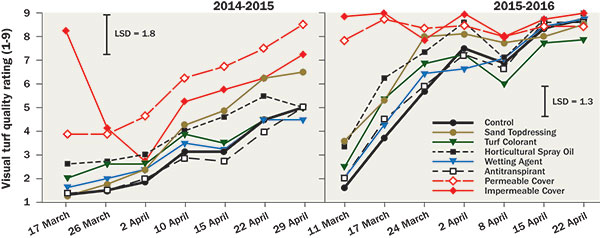
Figure 2 Turfgrass quality rating at the JSA Turf Research Center near Mead, Neb., following the winters of 2014-15 and 2015-16. Visual turfgrass quality ratings of 1 indicated completely dormant or dead turf, 6 indicated minimally acceptable turfgrass quality and 9 indicated perfect quality for a creeping bentgrass fairway. (Graph: Bill Kreuser)
Many superintendents also were using antitranspirants, wetting agents, horticultural oils and turf colorants in late winter, but most did not include a nontreated control area to evaluate the success of these products. The objectives of our research were to understand which products offered protection from winter desiccation stress and determine how these products sustained the crown moisture content of creeping bentgrass turf.
Five sites down to two
A series of field research experiments were initiated at five sites with a history of winter desiccation during the winters of 2014-15 and 2015-16. They included Awarii Dunes GC in Axtell, Neb., Sand Hills GC in Mullen, Neb., Monument Shadows GC in Gering, Neb., Dakota Dunes GC in Sioux City, S.D., and the JSA Turf Research Center near Mead, Neb.
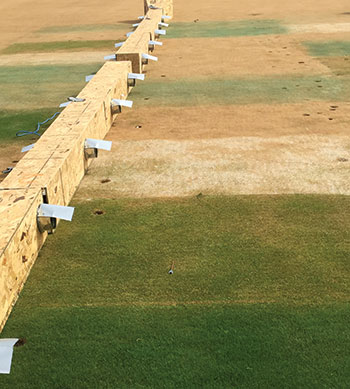
Figure 3 Turfgrass canopy after covers were removed in March 2014. Treatments include (bottom to top) GreenJacket impermeable cover, GreenJacket permeable cover, sand topdressing, nontreated control, Foursome turf colorant, Tournament Ready wetting agent, Transfilm antitranspirant and Civitas horticultural oil plus Harmonizer turf colorant. (Photo: Bill Kreuser)
All research sites were highly exposed, and only the site at Sand Hills GC received light winter irrigation at the superintendent’s discretion. The site at the JSA Turf Research center was covered with impermeable plastic before significant snow or rainfall. All other sites received natural precipitation. Only the Awarii Dunes and JSA Turf Research Center had significant winter desiccation injury during one or both years of the study. Research at these two sites are described in further detail below. The other sites received enough winter precipitation or irrigation to avoid winter desiccation injury.
The experiment was conducted on a creeping bentgrass golf course fairway (or fairway research plot) at Awarii Dunes (T-1) and the JSA Turf Research Center (L-93). The fairway turf received minimal sand topdressing during the growing season, were well watered throughout the fall and mowed at 0.5 inch. Both soils were predominantly sand, and there was approximately 0.5 inch of thatch across both plot areas.
We applied various winter desiccation prevention treatments in mid-November 2014 and 2015. They included both a permeable and impermeable turf cover (GreenJacket), heavy sand topdressing in late fall (0.20-inch depth), four spray-applied products (Table 1) and a nontreated control. We replicated all treatments four times at each site, and individual plots were 5 by 9 feet in size. Plugs were drilled out of the ground monthly at the JSA Turf Center from December until March to measure turf crown moisture content. Spring green-up was then monitored in the field at the JSA Turf Research Center. Because of travel constraints, two sets of plugs were removed to a greenhouse at the University of Nebraska-Lincoln in mid-March from the Awarii Dunes plots to measure crown moisture content and monitor green-up.
Desiccation presence and prevention
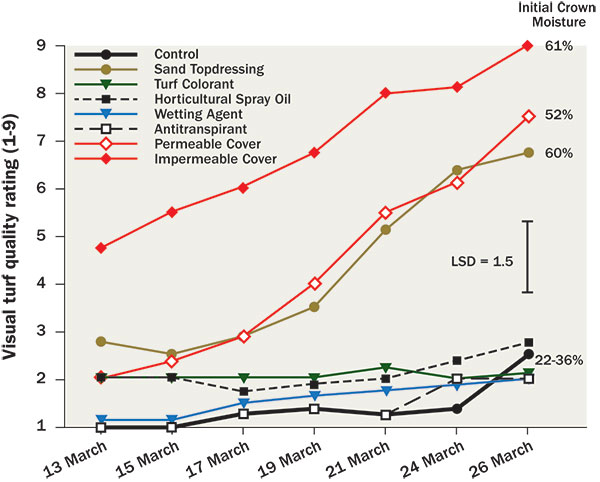
Figure 4 The probability of significant winter desiccation injury based on March crown moisture content and the resulting spring green-up. Treatments were considered victims of winter desiccation injury if turfgrass quality rating was below acceptable levels at the end of April in 2015 and 2016. The vertical dashed line represents the crown moisture content where there was a 50-percent probability of practically significant winter desiccation injury. (Graph: Bill Kreuser)
Covering the research area with a large tarp before snowfall resulted in significant winter desiccation injury at the JSA Turf Research Center. While natural precipitation was not excluded from Awarii Dunes GC, the site only received 1.25 inches of total liquid precipitation from December through mid-March; 0.95 inch occurred on Dec. 15, 2014. This led to significant winter desiccation injury and big differences in creeping bentgrass crown moisture content.
Sand topdressing and the two GreenJacket cover treatments helped prevent winter desiccation injury (Figures. 2 and 3). All three treatments had acceptable turf quality (greater than 6.0) six weeks after the covers were removed from the JSA Turf Research Center site. The covers stayed on the plots slightly longer than desired. This stimulated the turf to quickly break dormancy in early March. A hard freeze during mid-March 2015 caused the turfgrass quality rating of the impermeable cover treatment to plummet from near perfect (8.2) to an unacceptable level (2.8) in only nine days. Fortunately, the below-freezing temperatures were short-lived, and we removed the damaged leaves quickly during mowing (Figure 2).
Both the permeable and impermeable covers produced extremely high turf quality ratings following 2015-16 winter. Lack of a hard freeze in late March or April resulted in acceptable turf quality ratings for both covers. Clearly, superintendents should remove protective covers prior to active turf regrowth if there is still a risk of hard freeze.
The sand topdressing treatment always had unacceptable turfgrass quality at the end of winter (Figures 2 and 4). This occurred because the grass was covered in sand and exposed leaves were bleached brown. Sand topdressing protected the turf crown and resulted in rapid green-up each spring at both locations. Regular sand topdressing during the year and at the end of the season clearly have the potential to protect creeping bentgrass during winter desiccation stress.
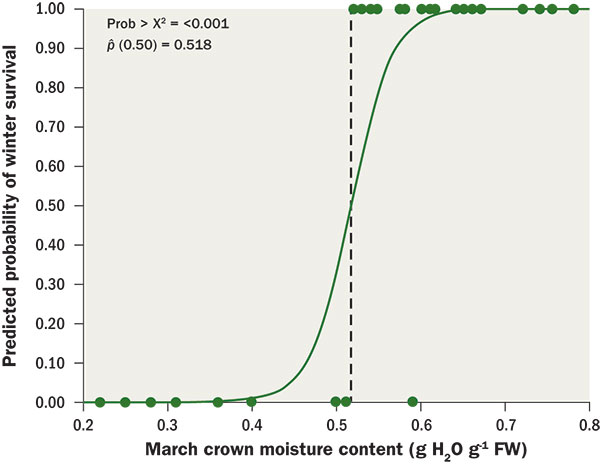
Figure 5 The probability of significant winter desiccation injury based on March crown moisture content and the resulting spring green-up. Treatments were considered victims of winter desiccation injury if turfgrass quality rating was below acceptable levels at the end of April in 2015 and 2016. The vertical dashed line represents the crown moisture content where there was a 50-percent probability of practically significant winter desiccation injury.(Graph: Bill Kreuser)
It also has the added advantage of a lower cost than protective covers, especially for tees and fairway turf, and doesn’t require labor in early spring to remove covers before the turf starts active regrowth. It’s likely that frequent in-season sand topdressing can help protect creeping bentgrass crowns from winter desiccation. That may explain why frequently topdressed creeping bentgrass greens had much less injury than tees and fairways following the winter of 2013-14.
The spray-applied treatments did not prevent winter desiccation injury at either site following the winter of 2014-15 (Figures 2 and 4). All of the spray-applied treatments and nontreated control had unacceptable turf quality ratings during the spring rating dates. Winter desiccation kills most, but rarely all, creeping bentgrass plants in a stand. This means that surviving plants slowly can reestablish an affected area.
The turf in the spray-applied plots did recover to creeping bentgrass — with some annual bluegrass — by the middle of July. This slow recovery would be completely unacceptable in a golf course setting.
The winter of 2015-16 was less severe at both study locations. At the JSA Turf Research Center, the spray-applied treatments had similar or slightly better turfgrass quality than the nontreated control. All treatments had acceptable turfgrass quality by the start of April 2016 (Figure 2). The story was similar at Awarii Dunes, except the Transfilm antitranspirant had acceptable turfgrass quality when the spring ratings began on March 13, 2016. All the plugs from Awarii Dunes treatments, including the nontreated control, recovered completely following the less severe winter of 2015-16.
Winter desiccation injury related to crown moisture
Winter tolerance of cool-season cereal crops like wheat, barley and turfgrass largely is dependent on the moisture content of the plant crown. This meristematic region is the growing point of these grasses. During fall, crown moisture content declines from approximately 80-85 percent to roughly 55-60 percent. As the water content in the crown declines, the freezing tolerance increases. As crown moisture content increases in spring — called deacclimation or crown hydration — cold tolerance declines. Crown hydration followed by cold temperatures is a common cause of annual bluegrass winterkill during late winter. This phenomenon occurred with the impermeable cover treatment during May 2015 at the JSA Turf Research Center.
Interestingly, wheat and barley cold hardiness can decline as crown moisture content falls below the normal winter 55-60 percent. We speculate that below-normal crown moisture from winter desiccation stress also may reduce cold tolerance in creeping bentgrass. Commonly, a windbreak north or northwest of creeping bentgrass turf provided some protection from winter desiccation injury. These winds typically are strong and extremely cold in the Great Plains.
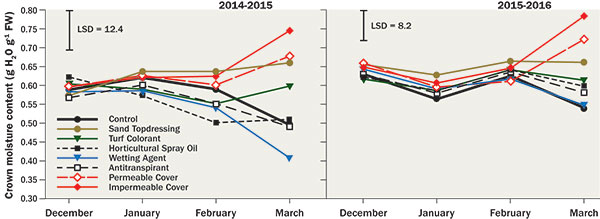
Figure 6 The crown moisture content of creeping bentgrass at the JSA Turf Research Center as a result of winter desiccation prevention treatment and winter month. (Graph: Bill Kreuser)
The results of our field studies clearly demonstrate the connection between March crown moisture and significant winter desiccation injury.
We used logistic regression to calculate the probability of winter desiccation survival at a given crown moisture content (Figure 5). This analysis indicates an equal probability of survival or significant injury when the crown moisture content was 51.8 percent. In fact, all the treatments that had mid-March crown moisture greater than 51.8 percent completely recovered from the winter desiccation stress.
Treatments with mean crown moisture less than 51.8 percent did not recover from winterkill in an acceptable amount of time (turf quality rating greater than 6 by the end of each study year). The lone exception was the turf colorant treatment from the JSA Turf Research Center following the winter of 2014-15. That treatment had a mean crown moisture content of 59 percent but still had unacceptable turfgrass quality (4.9) on April 29, 2015 (Figures 2 and 6).
Protection treatments affect turf crown moisture
Following the first winter at Awarii Dunes, all the spray-applied treatments and nontreated control had crown moisture contents less than 40 percent (Figure 2). All of those treatments also had significant and lasting winter injury. Sand topdressing and the two GreenJacket covers sustained creeping bentgrass crown moisture and led to rapid spring recovery. Less severe winter desiccation stress occurred during the second winter. All treatments and the nontreated control had crown moisture greater than 52 percent and made a complete recovery in 2016.
We monitored crown moisture monthly at the JSA Turf Research Center, and it was fairly stable during December and January (Figure 6). The crown moisture content of the different treatments began to change in mid-February. Still, all treatments were 56 percent or greater; well above the 51.8-percent injury threshold.
Crown moisture content for each treatment continued to diverge into March. The plots with GreenJacket covers increased crown moisture content and lost cold tolerance. The crown moisture of the nontreated control, antitranspirant, horticultural oil and wetting agent declined significantly from mid-February to mid-March.
This may suggest late winter poses the greatest risk of winter desiccation injury. Light applications of irrigation may be justified during this time. For example, all of the treatments at Sand Hills GC had crown moisture content of approximately 60 percent, likely because of light winter irrigation when temperatures were well above freezing and the ground was free of snow. Only small amounts of irrigation are required to sustain crown moisture because the crowns are quite small. Managers are not trying to irrigate leaves as they would in the summer.
Winter desiccation management recommendations
Dry and open winter conditions can lead to significant winter desiccation on creeping bentgrass turfgrass. These conditions can cause a reduction in crown moisture — especially in late winter — that can be lethal for many creeping bentgrass plants. Recovery can be extremely slow. Crown moisture measurements in early spring may help creeping bentgrass managers assess the risk of winter desiccation injury, but the measurement is extremely time consuming and tedious.
The permeable and impermeable GreenJacket protective covers sustained crown moisture and resulted in rapid green-up. Remove these covers in late winter to prevent premature deacclimation in the early spring.
Sand topdressing also is a viable alternative to protective covers. While turf quality following winter was unacceptable, sand topdressing led to fairly rapid spring recovery compared with the nontreated controls. Spray-applied treatments like Transfilm antitranspirant may offer some protection from mild winter desiccation stress, but protection is unlikely during severe winter desiccation stress.
Light applications of irrigation during warm and windy periods of winter also may help sustain turf crown moisture and limit winter desiccation injury. This practice is widely used across much of the Great Plains.
Bill Kreuser, Ph.D., is a turfgrass scientist at the University of Nebraska-Lincoln. You may reach Bill at wkreuser2@unl.edu for more information.
Acknowledgements
This research was part of Darrell J. Michael’s Master of Science degree at the University of Nebraska. The author would like to thank him for his hard work and persistence with this research. This study was funded by the USGA, Nebraska Turfgrass Association, University of Nebraska-Lincoln, the Peaks and Prairies GCSA and the Idaho GCSA.
References
Beard JB. 1973. Turfgrass: Science and Culture. Prentice-Hall, Englewood Cliffs, N.J. p. 291-295.
Frank, K.W. 2014. Turfgrass winterkill observations from the Great Lakes region. Appl. Turfgrass Sci. 11, 1-4.
Gusta, L. V., J. D. Butler, C. Rajashekar, and M. J. Burke. 1980. Freezing resistance of perennial turfgrasses. Hort. Sci. 15:494-496.
Hoffman, L., M. DaCosta, and J.S. Ebdon. 2014. Examination of cold deacclimation sensitivity of annual bluegrass and creeping bentgrass. Crop Sci. 54, 413.
Kreuser, W. 2014. Turfgrass winterkill observations from the upper Great Plains: desiccation and cold temperature. Appl. Turfgrass Sci. 11, 1-3.
Metcalf, E. L., C. E. Cress, C. R. Olein, E. H. Everson. 1970. Relationship between crown moisture content and killing temperature for three wheat and three barley cultivars. Crop Sci. 10, 362–365.
Richardson, M.D, J.T. Brosnan, and D.E. Karcher. 2014. Turfgrass winterkill observations from the transition zone. Appl. Turfgrass Sci. 11, 1-3.
Stier, J. C. and S. Z. Fei. 2008. Cold-stress physiology and management of turfgrasses. In Pessarakli, Mohammad (ed.) Handbook of Turfgrass Management and Physiology. Boca Raton, FL: CRC Press, Taylor & Francis Group.
Tompkins D, J. Ross, and D. Moroz. 2000. Dehardening of annual bluegrass and creeping bentgrass during late winter and early spring. Agron. J. 19, 5–9.
Webster, D. E., and J. S. Ebdon. 2005. Effects of nitrogen and potassium fertilization on perennial ryegrass cold tolerance during deacclimation in late winter and early spring. HortSci. 40:842-849.
White, D. B., and M. H. Smithberg. 1980. Cold acclimation and deacclimation in cool-season grasses. Int. Turfgrass Soc. Res. J. p.149-154.










